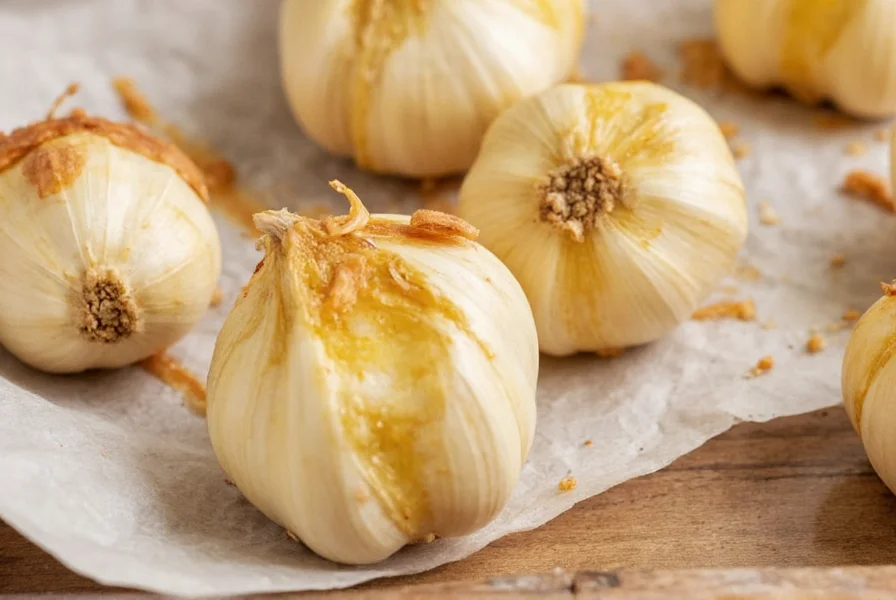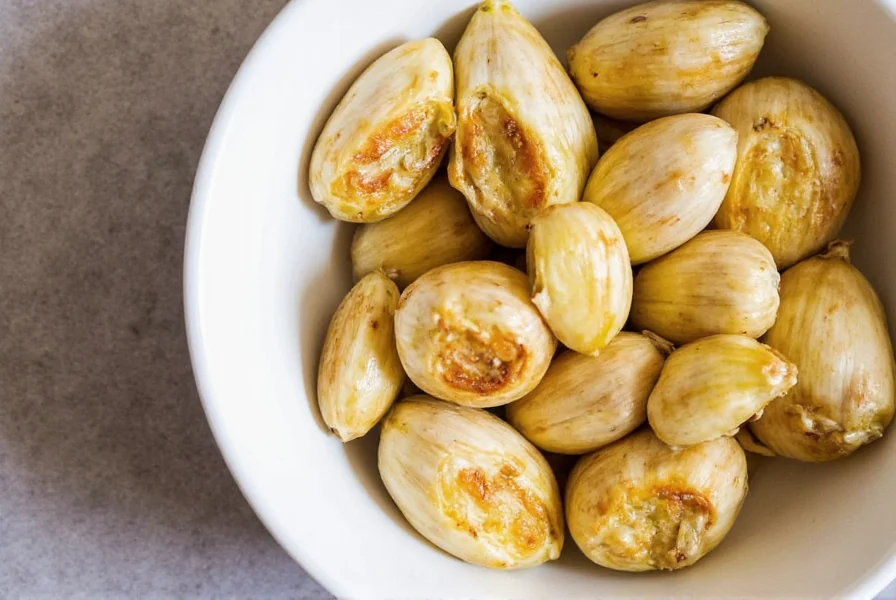The simplest way to roast garlic cloves is to toss peeled cloves with olive oil, salt, and herbs, then bake at 400°F (200°C) for 15-20 minutes until golden brown and tender. This transforms sharp raw garlic into sweet, mellow, spreadable cloves perfect for sauces, bread, or direct consumption.
Roasted garlic offers a completely different culinary experience from raw garlic. The high heat breaks down harsh compounds, creating a rich, nutty flavor with caramelized sweetness that enhances dishes without overwhelming them. Whether you're a beginner cook or seasoned chef, mastering this simple technique unlocks new dimensions in your cooking repertoire.
Why Roast Garlic Cloves?
Raw garlic contains allicin, the compound responsible for its pungent bite and strong aroma. When exposed to heat, allicin breaks down, resulting in a dramatically milder, sweeter flavor profile. Roasted garlic develops complex umami notes while maintaining its beneficial compounds. The texture transforms from crunchy to soft and spreadable, making it versatile for numerous applications.
Essential Equipment for Perfect Roasted Garlic
You need surprisingly few tools to roast garlic successfully:
- Oven-safe dish or aluminum foil
- Baking sheet (for individual cloves)
- Small bowl for mixing
- Measuring spoons

Step-by-Step Guide: How to Roast Garlic Cloves
Follow these precise steps for consistently perfect roasted garlic:
- Preparation: Peel garlic cloves while keeping them whole. For easier peeling, place cloves on a cutting board and gently press with the flat side of a knife.
- Seasoning: In a small bowl, combine cloves with 1-2 tablespoons olive oil, a pinch of salt, and optional seasonings like rosemary or thyme.
- Arrangement: Spread cloves in a single layer on a baking sheet or place in an oven-safe dish.
- Baking: Roast at 400°F (200°C) for 15-20 minutes, flipping halfway through. Cloves are done when golden brown and tender when pierced with a fork.
- Cooling: Let roasted garlic cool slightly before using, as it continues to cook from residual heat.
Comparing Roasting Methods
| Method | Temperature | Time | Best For |
|---|---|---|---|
| Oven Roasting | 400°F (200°C) | 15-20 minutes | Individual cloves for precise control |
| Whole Head Roasting | 375°F (190°C) | 40-50 minutes | Spreadable garlic paste applications |
| Stovetop Roasting | Medium heat | 10-15 minutes | Quick preparation without oven |
Visual Cues for Perfectly Roasted Garlic
Knowing when your garlic is perfectly roasted requires attention to specific indicators:
- Color change: From white to golden brown (avoid dark brown which indicates burning)
- Texture: Tender enough to pierce easily with a fork but not mushy
- Aroma: Sweet, nutty fragrance rather than sharp, pungent smell
- Size: Cloves will slightly shrink and wrinkle when perfectly roasted
Culinary Applications for Roasted Garlic
Roasted garlic's mellow flavor makes it incredibly versatile in the kitchen. Professional chefs often use it as a flavor foundation rather than a seasoning. Try these applications:
- Blend into mashed potatoes for rich depth
- Mix with softened butter for garlic bread
- Add to salad dressings for subtle complexity
- Stir into soups and stews during final minutes of cooking
- Spread on crostini as an elegant appetizer
- Incorporate into meatloaf or burger patties
Storage Techniques for Roasted Garlic
Proper storage extends the life of your roasted garlic while maintaining quality:
- Refrigeration: Store in an airtight container for up to 1 week
- Oil preservation: Submerge in olive oil in a sealed jar for up to 2 weeks in the refrigerator
- Freezing: Place cooled cloves in freezer bags for up to 6 months (thaw before using)
- Roasted garlic paste: Blend with a small amount of oil and freeze in ice cube trays for convenient portions
Troubleshooting Common Roasting Issues
Even simple techniques can encounter problems. Here's how to address frequent challenges when learning how to roast garlic cloves:
- Burnt edges: Reduce oven temperature to 375°F (190°C) and check frequently after 12 minutes
- Uneven cooking: Stir cloves halfway through roasting time
- Too moist: Extend roasting time by 3-5 minutes or spread cloves in single layer without crowding
- Lack of browning: Increase oven temperature by 25°F (15°C) or ensure cloves aren't overcrowded

Advanced Roasting Techniques
Once you've mastered the basic method for roasting garlic cloves, experiment with these professional variations:
- Citrus infusion: Add lemon or orange zest to the oil mixture for bright notes
- Smoked variation: Use smoked olive oil for a subtle barbecue-like flavor
- Spiced roasting: Toss with cumin, coriander, or smoked paprika before baking
- Caramelized finish: Sprinkle with a tiny amount of sugar during the last 5 minutes for deeper caramelization
Frequently Asked Questions
Can you roast garlic without oil?
Yes, you can roast garlic without oil using a covered dish to create steam, though the results will be less caramelized and slightly drier. For best flavor development, a small amount of oil (1 teaspoon per 6 cloves) significantly improves the texture and browning.
How do you prevent garlic from burning while roasting?
To prevent burning when roasting garlic cloves, use moderate heat (400°F/200°C), spread cloves in a single layer without crowding, and check after 12 minutes. Aluminum foil packets or covering the baking dish creates steam that protects against burning while still allowing caramelization.
What's the difference between roasted whole garlic cloves and roasted whole heads?
Roasting individual cloves creates distinct, separate pieces ideal for adding to dishes, while roasting whole heads produces a soft paste that squeezes easily from the skin. Whole heads require longer cooking (40-50 minutes at 375°F) and yield a more mellow flavor, while individual cloves roast faster (15-20 minutes) with slightly more pronounced garlic character.
Can you roast garlic in an air fryer?
Yes, air fryers work excellent for roasting garlic cloves. Toss peeled cloves with oil and roast at 375°F (190°C) for 10-12 minutes, shaking the basket halfway through. The circulating hot air creates even browning with minimal oil needed, making this one of the quickest methods for how to roast garlic cloves.
Why does my roasted garlic taste bitter?
Bitterness in roasted garlic typically indicates burning or over-roasting. Garlic contains compounds that turn bitter when exposed to excessive heat. To prevent this, monitor cloves closely during the final minutes of roasting, and remove them from heat as soon as they turn golden brown rather than waiting for darker caramelization.










 浙公网安备
33010002000092号
浙公网安备
33010002000092号 浙B2-20120091-4
浙B2-20120091-4